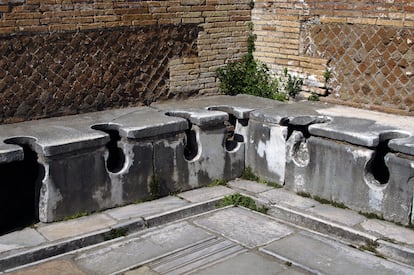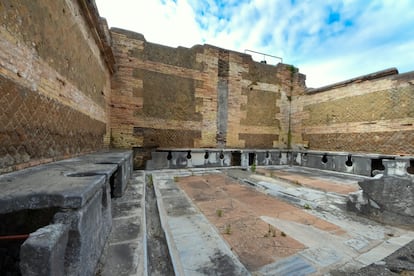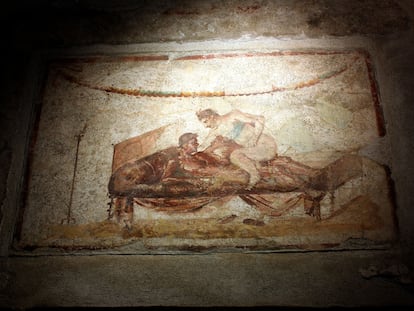‘Cacator cave malum’: what collective latrines teach us about ancient Rome
They were spaces to share stories, jokes, and even a sponge attached to a stick that they used to clean themselves. “If you want to understand the culture, look at its bathrooms,” says the scholar Mary Beard

“I love this place,” exclaims the English scholar Mary Beard in How the Romans lived, one of her historical documentaries for the BBC. The monument she is referring to is a public latrine.
Defecation, for the Romans, was not always a private matter. They shared stories, jokes… and even a sponge attached to a stick that they used to clean themselves.
“If you want to understand the culture, look at its baths,” says Beard, sitting in a nearly intact latrine at Ostia Antica, one of Italy’s best-preserved ruins, reachable from Rome by commuter train. “In the center of Rome, according to an ancient guide, there were 144 latrines, although we do not know how many seats each one had,” continues the Cambridge-trained historian, who has authored books such as Pompeii.

In the documentary, Beard asks questions about the use of public latrines: were they co-ed? What were the small canals at the bottom of the structures used for?
“This is how we should imagine the old city: everyone going to the bathroom at the same time. Toga up, pants down, chatting all the while.”
The fascination with Roman latrines is not unusual among specialists of the ancient world. An enormous amount of information can be extrapolated from the defecative customs of the Romans and, in general, from their relationship with bathrooms.
Historian Andrew Wallace-Hadrill, an expert on the cities destroyed by Mount Vesuvius’ volcanic eruption in the year 79 AD, carried out an exhaustive investigation of the remains of feces that were preserved in Herculaneum. He discovered some objects that were lost in the almost fossilized human waste and obtained a lot of information about the Roman diet. Foods like chicken, lamb, fish, figs, fennel, olives, sea urchins and mollusks were “a completely standard diet for ordinary townspeople,” he explained in a documentary for National Geographic. “It’s a very good diet; any doctor would recommend it.”

Researcher Barry Hobson, who spent 14 years excavating Pompeii, is the author of two reference books on the subject: Toilets in the Roman world and Pompeii latrines. By analyzing toilets and public latrines, Hobson provides a great deal of information about the Roman world – about its sense of privacy, for example. Collective baths reflect a considerable distance from the Western world today, where this matter is almost always private. On the other hand, many individual baths have also been found in Roman ruins.
Hobson recounts a story told by Seneca about a gladiator committing suicide with a sponge when he went to the bathroom unaccompanied, which would mean that he claimed privacy:
“During a gladiatorial fight with the wild beasts, one of the Germans who was to participate in the morning show retired to the outhouse – nowhere else was he allowed to go without an escort,” wrote the philosopher and adviser to Emperor Nero. “There, [he took] the stick that, attached to a sponge, is used to clean the impurity of the body, stuffed it all into the throat and drowned.”
However, both archeology and graffiti reflect a clear fraternization in the multi-seater latrines. A mysterious and disturbing epigram carved into several places in Pompeii reads: “Cacator cave malum” – or “pooper, be careful,” which warned of hidden evil that one could find in the latrines. Other graffiti indicated which well-known individual had relieved himself in which location, or warned against defecating in a certain area.
Hobson also studied the concept of hygiene in ancient Rome and, above all, if its inhabitants were aware of the danger that the accumulation of feces represented, beyond the stench.
“Did the Romans know about the health problems that human excrement could pose?” he writes. He doesn’t find a clear answer, but he considers that “the transmission of diseases was misunderstood.” He emphasizes, however, that 19th-century London was not much more hygienic than Pompeii in the 1st century. It is true that the Romans had a strong relationship with water, via aqueducts and baths, but their concept of hygiene was very different. In the hot springs, for example, the water was stagnant – taking a dip with a foot injury was a bad idea.
One of the best works that analyzes the Roman world from the point of view of baths, water and latrines is actually a manga, Thermae romae, by Mari Yamazaki. It has also been released as an anime series on Netflix. It tells the story of a Roman spa engineer who travels forward in time to present-day Japan, where he learns all kinds of tricks to improve his buildings.
With great humor and careful historical research, Yamazaki shows what united two cultures for which hot springs were an essential element, but also what separated them: for instance, the Romans were light years away from the Japanese obsession with keeping toilets clean. In fact, one of the first chapters of the series shows the abyss that separates the Roman foricae, with their disgusting sponges, from the technologically-advanced Japanese toilets.
Tu suscripción se está usando en otro dispositivo
¿Quieres añadir otro usuario a tu suscripción?
Si continúas leyendo en este dispositivo, no se podrá leer en el otro.
FlechaTu suscripción se está usando en otro dispositivo y solo puedes acceder a EL PAÍS desde un dispositivo a la vez.
Si quieres compartir tu cuenta, cambia tu suscripción a la modalidad Premium, así podrás añadir otro usuario. Cada uno accederá con su propia cuenta de email, lo que os permitirá personalizar vuestra experiencia en EL PAÍS.
¿Tienes una suscripción de empresa? Accede aquí para contratar más cuentas.
En el caso de no saber quién está usando tu cuenta, te recomendamos cambiar tu contraseña aquí.
Si decides continuar compartiendo tu cuenta, este mensaje se mostrará en tu dispositivo y en el de la otra persona que está usando tu cuenta de forma indefinida, afectando a tu experiencia de lectura. Puedes consultar aquí los términos y condiciones de la suscripción digital.
More information
Últimas noticias
David Bowie, the galactic thinker who encouraged us to break new ground
John Berger and the loss of rural culture
From police officer to bloodthirsty kidnapper: Terror in Mexico during the years of ‘The Ear Chopper’
Alain Aspect, Nobel laureate in physics: ‘Einstein was so smart that he would have had to recognize quantum entanglement’
Most viewed
- David King, chemist: ‘There are scientists studying how to cool the planet; nobody should stop these experiments from happening’
- Reinhard Genzel, Nobel laureate in physics: ‘One-minute videos will never give you the truth’
- Oona Chaplin: ‘I told James Cameron that I was living in a treehouse and starting a permaculture project with a friend’
- Mexico completes its trade shift with the entry into force of tariffs on China and countries without trade agreements
- Sinaloa Cartel war is taking its toll on Los Chapitos










































